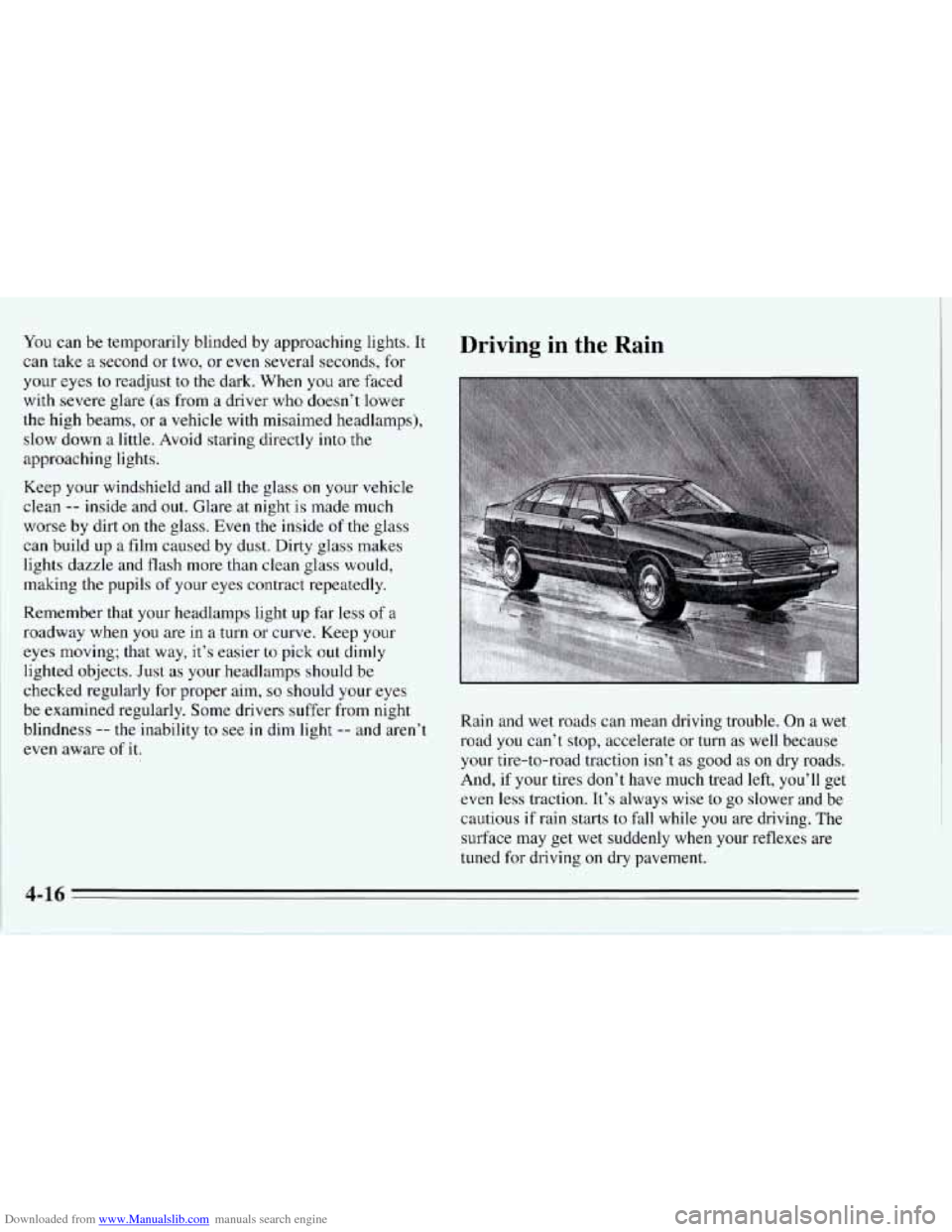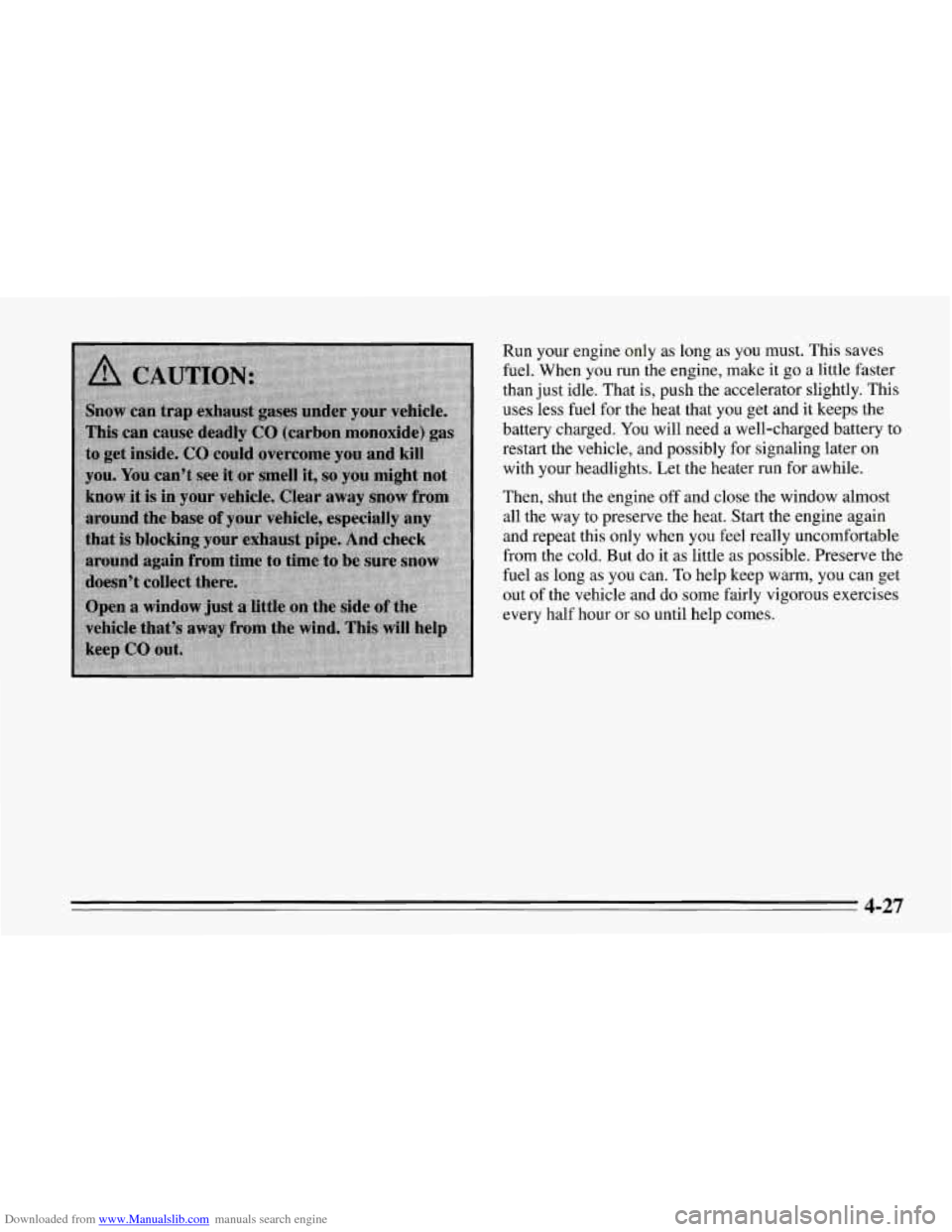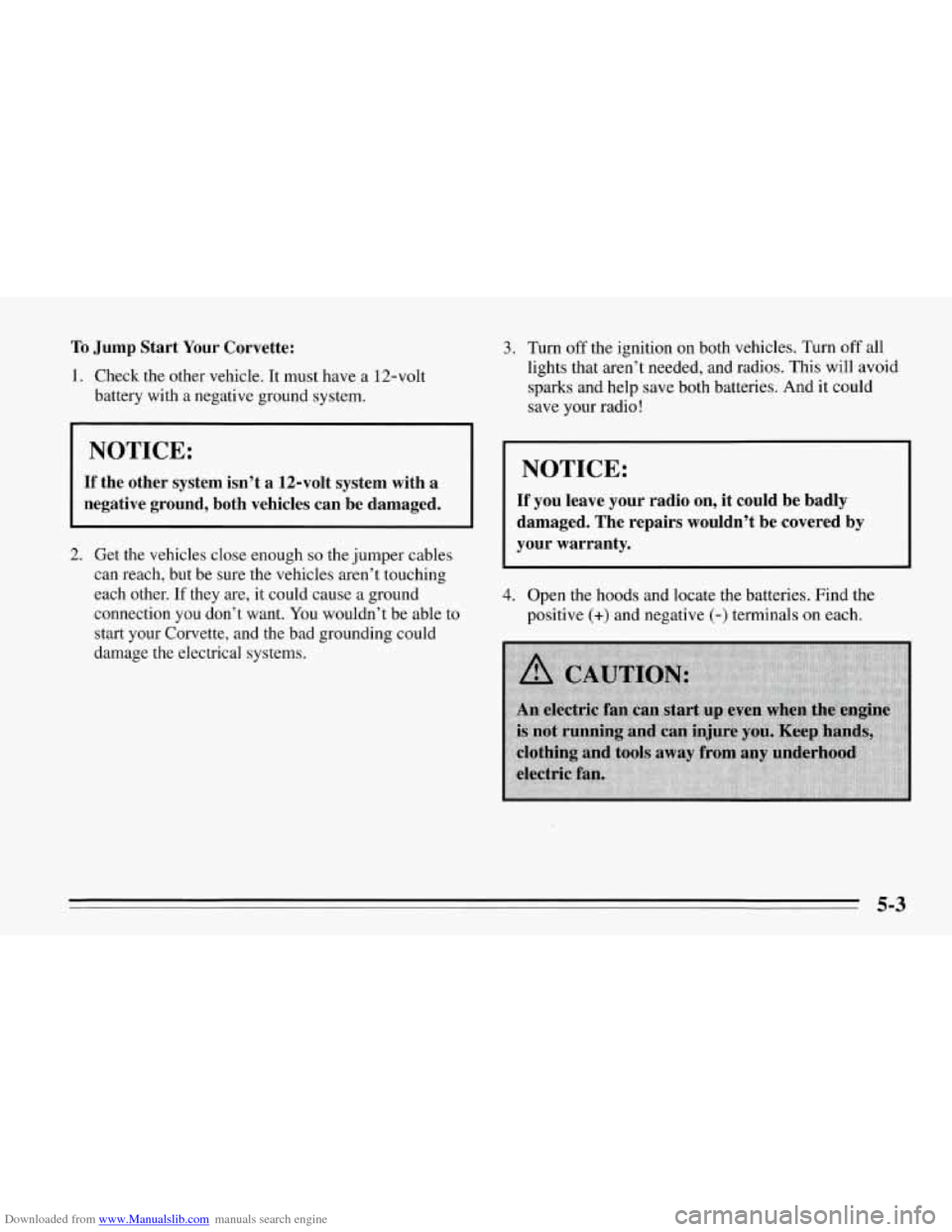1995 CHEVROLET CORVETTE lights
[x] Cancel search: lightsPage 179 of 386

Downloaded from www.Manualslib.com manuals search engine You can be temporarily blinded by approaching lights. It
can take a second or two, or even several seconds, for
your eyes to readjust to the dark. When you are faced
with severe glare (as from a driver who doesn’t lower
the high beams, or a vehicle with misairned headlamps),
slow down a little. Avoid staring directly into the
approaching lights.
Keep your windshield and all the glass on your vehicle
clean
-- inside and out. Glare at night is made much
worse by dirt on the glass. Even the inside of the glass
can build up a film caused by dust. Dirty glass makes
lights dazzle and flash more than clean glass would,
making the pupils of your eyes contract repeatedly.
Remember that your headlamps light
up far less of a
roadway when you are
in a turn or curve. Keep your
eyes moving; that way, it’s easier
to pick out dimly
lighted objects. Just as your headlamps should
be
checked regularly for proper aim, so should your eyes
be examined regularly. Some drivers suffer from night
blindness
-- the inability to see in dim light -- and aren’t
even aware of it.
Driving in the Rain
Rain and wet roads can mean driving trouble. On a wet
road you can’t stop, accelerate or turn as well because
your tire-to-road traction isn’t as good as
on dry roads.
And,
if your tires don’t have much tread left, you’ll get
even
less traction. It’s always wise to go slower and be
cautious
if rain starts to fall while you are driving. The
surface may get wet suddenly when your reflexes are
tuned for driving on dry pavement.
4-16
Page 190 of 386

Downloaded from www.Manualslib.com manuals search engine Run your engine only as long as you must. This saves
fuel. When you run the engine, make it go a little faster
than just idle. That is, push the accelerator slightly. This
uses less fuel for the heat that you get and it keeps the
~ battery charged. You will need a well-charged battery to
restart the vehicle, and possibly for signaling later on
with your headlights. Let the heater run for awhile.
Then, shut the engine off and close the window almost
all the way to preserve the heat. Start the engine again
and repeat this only when you feel really uncomfortable
from the cold. But do it as little as possible. Preserve the
fuel as long as you can. To help keep warm, you can get
out of the vehicle and do some fairly vigorous exercises
every half hour or
so until help comes.
4-27
Page 196 of 386

Downloaded from www.Manualslib.com manuals search engine To Jump Start Your Corvette:
1. Check the other vehicle. It must have a 12-volt
battery with a negative ground system.
NOTICE:
If the other system isn’t a 12-volt system with a
negative ground, both vehicles can be damaged.
2. Get the vehicles close enough so the jumper cables
can reach, but be sure the vehicles aren’t touching
each other.
If they are, it could cause a ground
connection
you don’t want. You wouldn’t be able to
start your Corvette, and the bad grounding could
damage the electrical systems.
3. Turn off the ignition on both vehicles. Turn off all
lights that aren’t needed, and radios. This will avoid
sparks and help save both batteries. And
it could
save your radio!
NOTICE:
If you leave your radio on, it could be badly
damaged. The repairs wouldn’t be covered by
your warranty.
4. Open the hoods and locate the batteries. Find the
positive
(+) and negative (-) terminals on each.
5-3
Page 262 of 386

Downloaded from www.Manualslib.com manuals search engine What to Use What to Use
To add lubricant when the level is low, use Axle
Lubricant (GM Part
No. 12345977) or SAE SOW-90
GL-5 gear lubricant.
To completely refill after draining,
add
4 ounces (1 18 ml) of Limited-Slip Differential
Lubricant Additive (GM Part
No. 1052358). Then fill to
the bottom of the filler plug hole with Axle Lubricant
(GM Part
No. 12345977) or SAE 8OW-90 GL-5 gear
lubricant.
Engine Coolant
The following explains your cooling system and how to
add coolant when it is low.
If you have a problem with
engine overheating or if you need to add coolant to your
high fill reservoir, see “Engine Overheating” in the
Index.
The proper coolant for your Corvette will:
Give freezing protection down to -34°F (-37°C).
Give boiling protection up to 262 “F (128 ” C).
Protect against rust and corrosion.
Help keep the proper engine temperature.
Let the warning lights work as they should. Use a mixture
of one-half
clean water (preferably
distilled) and one-half antifreeze that meets
“GM
Specification 1825M,” which won’t damage aluminum
parts.
You can also use a recycled coolant conforming to
GM Specification 1825M with a complete coolant flush
and refill. Use GM Engine Coolant Supplement (sealer)
with any complete coolant flush and refill. If
you use
this mixture, you don’t need to add anything else.
6-27
Page 380 of 386

Downloaded from www.Manualslib.com manuals search engine Fog ....................................... 2-48
FrontMap
.................................. 2-49
Interior
.................................... 2-49
Lamps On Reminder
............................ 2-46
Lane Change Indicator
........................... 2-40
Lap Belt Cinch Feature
.......................... 1 - 12
Larger Children. Safety Belt Use
................... 1-28
Latches. Seatback
................................ 1-3
Leaving Your Vehicle
............................. 2-4
Air Bag Readiness
........................... 2-69
Leaving Your Vehicle With the Engine Running
....... 2-34
Lights
Anti-Lock Brake System Active
................ 2-72
Anti-Lock Brake System Warning
........... 2-72. 4-6
ASR (Acceleration Slip Regulation)
System Active
............................ 2-74
System Off
............................... 2-73
System Warning
....................... 2-73. 4-8
Brake System Warning ........................ 2-70
Charging System
............................. 2-70
CheckGauges
............................... 2-85
DoorAjar
.................................. 2-78
LowCoolant
................................ 2-75
LowOil
.................................... 2-86
Low Tire Pressure Warning System
.............. 2-76
Parking Brake Indicator
....................... 2-71
Passive Keyless Entry
......................... 2-88
Safety Belt Reminder
..................... 1-6. 2-69
Security
.................................... 2-88
Service Engine Soon
.......................... 2-80
ServiceLTPWS
.............................. 2-78
Service Ride Control
.......................... 2-87
Lighter. Cigarette
............................... 2-61 Limited-Slip
Rear Axle
.......................... 2-31
Loading Your Vehicle
........................... 4-28
Locks
Door ....................................... 2-3
PowerDoor
.................................. 2-4
Steering Column
............................. 7-43
Long Trip, Before Leaving on a
.................... 4-21
Loss
of Control ................................ 4-14
Low Coolant Light
.............................. 2-75
LowOilLight
................................. 2-86
Low Tire Pressure Warning System Light
............ 2-76
Lubrication, Body
.............................. 7-42
Lumbar Controls, Power Seat
.................... 1-2
Maintenance Record
........................... 7-48
Maintenance Schedule
............................ 7-1
Owner Checks and Services
.................... 7-41
Periodic Maintenance Inspections
............... 7-44
Recommended Fluids and Lubricants
............ 7-45
Schedule1
................................... 7-6
Schedule
I Definition .......................... 7-4
Schedule11
................................. 7-29
Schedule I1 Definition
.......................... 7-5
Scheduled Maintenance Services
................. 7-2
Maintenance, Normal Replacement Parts
............ 6-77
Maintenance, Underbody Flushing
................. 7-43
Malfunction Indicator Lamp
(Service Engine Soon Light)
..................... 2-80
Manual Air Conditioning Controls
.................. 3-1
ManualBi-Level
................................ 3-7
ManualCooling
................................. 3-7
Manual Front Seat
............................... 1-1
9-7
Page 385 of 386

Downloaded from www.Manualslib.com manuals search engine TopStrap ..................................... 1-25
TorqueLock
................................... 2-34
Torque. Wheel Nut
......................... 5.36. 6.77
Towing a Trailer
................................ 4-29
Towing Your Vehicle
............................. 5-6
Trailer, Towing a
............................... 4-29
Transmission Fluid, Automatic
.................... 6-20
Transmission Fluid, Manual
....................... 6-23
Transmitters, Matching to Your Vehicle
.............. 2-7
Trip Odometer
................................. 2-68
Turn Signal and Lane Change Indicator
............. 2-40
Turn Signals/Headlamp Beam Lever
................ 2-39
Front
....................................... 5-9
Rear
....................................... 5-11
Underbody Flushing
........................... 7-43
Underhood Lamps Fuse
.......................... 6-73
Universal Theft-Deterrent
...................... 2- 12
Vehicle Damage Warnings
......................... ix
Vehicle Dimensions Chart
........................ 6-79
Vehicle Identification Number (VIN)
............... 6-66
Vehicle Loading
................................ 4-28
Vehicle Storage
................................ 6-36
Vehicle Symbols ................................... x
Vehicle. Leaving Your
............................ 2-4
Vehicle.
Control of a
............................. 4-5
Vehicles First
Sold in Canada 11 .. ........................
Ventilation System. Flow-Through ................. 3- 10
Ventilation Tips
................................ 3-10
Visor Vanity Mirrors, Covered
..................... 2-51
Visors, Sun
.................................... 2-51
Vision.
Night
.................................. 4-15
Voltmeter
..................................... 2-79
warning Devices
............................... 5-2
Warning Flashers. Hazard
......................... 5-1
Washing Your Vehicle ........................... 6-61
Weatherstrips
.................................. 6-60
Wheel Nut Torque
......................... 5-36. 6-77
Wheel Replacement
............................. 6-54
Wheel Replacement. Used
........................ 6-55
Window
...................................... 2-37
Express Down Feature
........................ 2-37
Power
..................................... 2-37
Windshield, Specially Treated (ZR-
1) ................ 3-9
Windshield Washer ............................. 2-42
Windshield Washer Fluid
.................... 2-42. 6-31
Windshield Wiper Blade Replacement
.............. 6-47
Windshield Wiper Fuses
......................... 6-68
Windshield Wipers
.............................. 2-41
Winter, Driving in
.............................. 4-24
Wiring, Headlamp
.............................. 6-68
Wrecker Towing
................................. 5-6
Warning
Lights. Gauges and Indicators
.............. 2-68
Water. Driving Through Deep Standing
............. 2-22
9-12